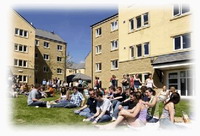US students hardly keep up with rising college prices
The college price in the United States jumped up faster than the inflation rate this year, climbing 6.6 percent at four-year public schools and outstripping increases in the financial aid that lowers what most students actually pay.

The latest increases, reported Monday by the College Board, bring the average list price of four-year public universities to $6,185 (4,366 EUR) this year, up $381 (269 EUR) from 2006-2007. At four-year private colleges, tuition and fees rose 6.3 percent to $23,712 (16,739 EUR).
Public two-year colleges - which educate about half of American college students - again got the best marks for keeping a lid on price increases. Their average price rose 4.2 percent to $2,361 (1,667 EUR). Accounting for aid, their average net cost is only $320 (226 EUR) per year.
"For too long, parents have grimaced and borne the high price of college because they presumed that a higher education is key to their child's success in today's economy," said James Boyle, president of the group College Parents of America, in a statement on the report. "Surely, the day will come - soon - when parents say enough is enough."
The published price is not the real price for many students, thanks to financial aid, but the net price is rising too. On average, accounting for grants and tax breaks, the net price for full-time students at four-year public universities this year is $2,580 (1,821.26 EUR). That's about $160 (113 EUR) more than last year.
At private colleges, net cost this year averages $14,400 (10,165.18 EUR) - up $638 (450.37 EUR) from a year ago.
To make up the difference, students typically borrow as much as allowed from the federal government, but then turn to private student loans. A decade ago, nonfederal loans accounted for about 6 percent of student aid, but last year they were 24 percent.
The rate of growth in private borrowing slowed last year. But that was at least partly because of new rules allowing graduates students to take out PLUS loans from the federal government, reducing their need for private loans. For undergraduates, private borrowing still rose 12 percent to $14.5 billion (10.24 billion EUR).
Including room and board for students living on campus, charges for public four-year colleges were $13,589 (9,593 EUR), or 5.9 percent higher than last year. At private four-year schools, average total charges come to $32,307 (22,806 EUR).
George Washington University in Washington, D.C. recently attracted attention for becoming the first major university with a published price, including room and board, of more than $50,000 (35,296 EUR).
However, the percentage of college-goers who pay such large sums is fairly small. Fewer than 10 percent of students even attend colleges with tuition and fees higher than $30,000 (21,177 EUR), according to the College Board, and many of those students receive financial aid. About 56 percent of students at four-year colleges attend schools listing a price under $10,000 (7,059 EUR), and about one-third attend schools charging under $6,000 (4,235 EUR).
The College Board's report does not try to explain why prices keep going up, though Sandy Baum, an economist with the group and at Skidmore College, points out that because of rising demand for higher education, more state appropriations have not translated into more money spent on each student.
Subscribe to Pravda.Ru Telegram channel, Facebook, RSS!


